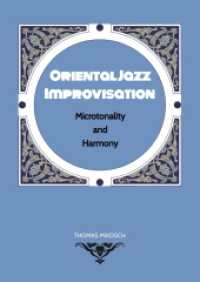Full Description
This book is the first treatise in English to present an overall functional necessity approach to the study of the legal position of intergovernmental organizations. According to this approach, an international organization is entitled to (no more than) what is necessary for the exercise of its functions in the fulfillment of its purposes. The book embodies a three-step analysis that links an organization's legal status (personality/ capacity/powers) and immunities to the functions and purposes of the organization. The book also reviews existing methods of counterbalancing organizational immunities and includes the International Tin Council litigation as a case study.
With a Foreword by Sir Robert Jennings.
"It is a book which deserves a place in specialized international law collections, and certainly on the shelves of anyone, be they a government or private party, who has any legal dealings with international organizations."
—Maurice Mendelson, Book Review, XXIII(4) Law Books in Review 159 (1996)
Contents
Contents
Foreword
Preface
Preface to the Second Revised Edition
Abbreviations
1 Introduction
1 Purpose and Scope of This Study
2 The Work of the International Law Commission on Relations between States and International Organizations (1962-1992)
2.1 The Early Stages
2.2 The First Part of the Topic
2.2.1 The Work of Special Rapporteur El-Erian
2.2.2 Codification and Progressive Development of International Law: The 1975 Vienna Convention
2.3 The Second Part of the Topic
2.3.1 The Work of Special Rapporteur El-Erian Continued
2.3.2 Díaz González: A New Special Rapporteur - A New Approach?
2.4 Current Status: The 1992 Report of theilc's Planning
Group
2 A Three-Step Functional Necessity Analysis
1 Step One Identification. Functional Necessity in Legal Status: Subject-Matter and Scope Ratione Personae
1.1 Introduction
1.2 The Concept of Function
1.3 The Elements of Legal Status
1.3.1 Introduction
1.3.2 A Division into Three Elements
1.3.2.1 The First Element: Personality
1.3.2.2 The Second Element: Capacity
1.3.2.3 The Third Element: Competence
1.4 Draft Articles on Legal Status by the International Law Commission
2 Step Two Selection
2.1 Introduction
2.2 Why: Basic Considerations in Granting Organizational Immunities
2.2.1 Introduction
2.2.2 (i) Political Independence of the Organization
2.2.3 (ii) Impartiality of the Organization
2.2.4 (iii) Equality of the Member States
2.2.5 (iv) Avoidance of Undue National Financial
Advantage: Financial Independence
2.2.6 (v) Precedent and Equality of Status with Other Organizations
2.2.7 (vi) Prestige and Authority of the Organization
2.2.8 (vii) The Need for Special Protection in Initial Stages
2.2.9 Conclusion
2.3 What: Functional Necessity as a Basis for Selecting Organizational Immunities
2.3.1 Introduction
2.3.2 A List of Organizational Immunities
2.4 Where: Legal Bases of Organizational Immunities
2.4.1 Introduction
2.4.2 Treaties
2.4.2.1 Constituent Instruments of International Organizations
2.4.2.2 General Multilateral Agreements
2.4.2.3 Bilateral Agreements
2.4.3 Domestic Legislation
2.4.4 Customary International Law
2.4.5 Conclusion
3 Step Three Extent - Scope Ratione Materiae. The Role of Functional Necessity as a Yardstick for Determining the Extent of Organizational Immunities
3.1 Introduction
3.2 Organizational Immunities versus Other Types of Immunities
3.3 Organizational Immunities Are Neither 'Absolute' Nor 'Restrictive'
3.4 'Official Activity' versus 'Commercial Activity'
3.4.1 The 'Official Activity' Criterion Applied: The EMBL Award
3.4.2 Determination of 'Official Activity': By Whom?
3.5 Conclusion
3.6 Methods of Counterbalancing Organizational Immunities
3.6.1 Introduction
3.6.2 Settlement of Disputes Concerning Alleged Abuse of Immunities
3.6.2.1 Introduction
3.6.2.2 Abuse Procedures: A Classification
3.6.3 General Settlement of Disputes Procedures
3.6.3.1 Introduction
3.6.3.2 Waiver of Immunity
3.6.3.3 International Judicial Settlement; Arbitration
3.6.4 Additional Procedures
3.6.5 Responsibility of Intergovernmental Organizations
3.6.6 Conclusion
3 The Functional Concept Applied: The International Tin Council
1 Introducing: The Tin Crisis
2 Step One: The Status of the ITC as an Organization
3 Step Two: The Immunities of the ITC
4 Step Three: The Extent of the Immunities of the ITC
4 General Conclusion
Selected Bibliography
Legal Aspects of International Organization
Index







